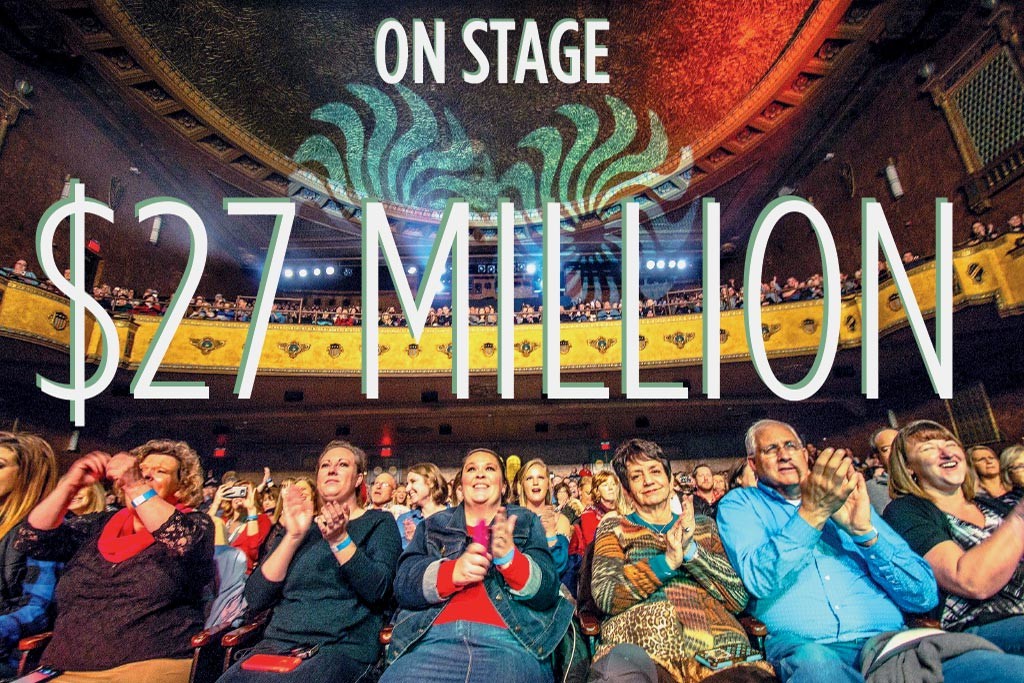YOUR BUSINESS AUTHORITY
Springfield, MO
YOUR BUSINESS AUTHORITY
Springfield, MO

The first Friday of every month signals a special night for downtown Springfield. Residents across the city roam the streets and peruse galleries for what is known as Art Walk.
Springfield Regional Arts Council Executive Leslie Forrester says events like First Friday Art Walk encourage the community to see the arts industry as equally valuable as any other.
According to a first-of-its kind study in Springfield, the arts mean big business in the city – to the tune of $27 million a year.
“I was surprised,” Forrester said of the Arts & Economic Prosperity study results released this month. “Not because I didn’t think it was impactful, but because I had no previous basis for knowing what that number looked like. This is the first time we’ve done this type of study of this size.”
The study by nonprofit Americans for the Arts measures the economic impact of the nation’s arts and cultural organizations and audiences. Now in its fifth year, the Prosperity study reviews cities individually, and for the first time it researched the Queen City.
Of the $26.9 million economic impact in 2015, audiences spending on tickets, dining, retail and lodging generated $17.1 million, and organizations producing the events generated $9.8 million.
Those numbers supported 1,065 full-time art industry jobs and contributed $1.3 million in local government revenue, as well as $1 million in state government revenue.
“Those were exciting numbers to see,” Forrester added.
Nationwide, Americans for the Arts found arts and cultural organizations and audiences generated $166.3 billion of economic activity in 2015, supporting 4.6 million jobs and contributing $27.5 billion in revenue to local, state and federal governments.
In Missouri, the St. Louis arts scene led with $590.9 million in economic impact, and Hannibal’s was on the low end in the study, at roughly $5 million.
Compared with other cities with population in the 160,000 range, the arts and culture industry in Springfield appears to be about average. For instance, in like-sized Middlesex County, Connecticut, the economic impact was $32 million and in Eugene, Oregon, it was $62.2 million.
Among participating organizations for the Springfield study were the Springfield Art Museum, Springfield Ballet, the Moxie Cinema and Dickerson Park Zoo.
Forrester speculated attractions that regularly welcome large audiences, such as theaters, contribute most.
Juanita K. Hammons Hall Executive Director Keith Boaz agreed.
“People like to make a night out of those evenings, where you go out for dinner. You might possibly buy a new outfit,” Boaz said. “It does contribute to Springfield as a whole.”
Boaz said the city’s desire for Broadway performances has accumulated millions of dollars in ticket sales.
“When we brought in ‘Wicked’ in February 2016, we sold a little over 34,000 tickets for 16 performances,” Boaz said.
Boaz declined to disclose Hammons Hall’s annual revenue, but Springfield Business Journal previously reported it grossed $3.7 million in sales during its 2015-16 season, roughly four times the revenue compared with the prior season. “Wicked” audience members from 37 states bought 97 percent of all possible tickets, and probably continued to spend money at hotels, restaurants and other retailers.
“It’s a staggering percentage,” he said. “All of our Broadway shows do really, really well. We certainly have the hopes that ‘The Phantom of the Opera’ will do as well as ‘Wicked.’”
The classic Broadway performance is set to hit Hammons Hall’s stage for the first time in May 2018, and Boaz said three or four more blockbuster attractions are on their way, too.
Gillioz Theatre Associate Director Joy Bilyeu-Steele said most of the downtown theater’s revenue is generated by ticket sales, in addition to alcohol and concessions sales.
Many individuals and organizations also rent out the theater for events.
“A lot of graduations and churches utilize us,” Bilyeu-Steele said.
Declining to disclose theater revenue, Bilyeu-Steele said the Gillioz has increased sales each year for the last five years.
“It’s certainly a growing community,” Forrester said of the arts. “More shows are coming in to places like the Gillioz. The Springfield Symphony has also had record ticket sales.”
Comedy and improv shows also are picking up around the city.
“You’re seeing more and more ads for various events like that, Artsfest and Cider Days, too. They appear to be gaining more traction,” Boaz added.
Looking ahead, Forrester said the SRAC would build upon this now known economic engine. “We’ll be working with all communities, like the business community and the religious community, to connect them too,” she said. “It’s one of the most versatile industries that can connect with all other industries locally.”
[[In-content Ad]]
Connected to Watkins Elementary School is a new storm shelter now under construction.
STL construction firm buys KC company
Updated: Systematic Savings Bank to be acquired in $14M deal
Missouri House speaker accused of obstruction in ethics probe
Webster University's deficit triples
‘Dress for your day’: Companies are relaxing dress codes amid evolving ideas about fashion